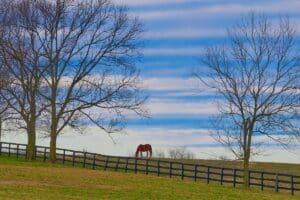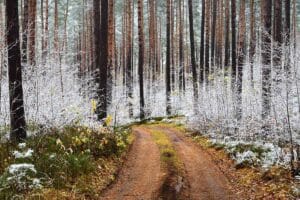Twenty-seven years ago on Father’s Day, I spent a sunny couple of hours digging a grave on top of a pretty West Virginia hill.
It went slowly below the topsoil, with just a spade and a mattock. Dense clay came first, then I hit sandstone that grew more stubborn the deeper I got. On the other hand, I wasn’t in a hurry.
It wasn’t long before I was reduced to scraping at the sandstone with the mattock’s blade. Each inch got harder, and I got hotter. Still, I felt progress was being made toward accomplishing something useful.
Graves need to be bigger than coffins—both longer and wider. You need to fight your lazy-bones tendency to narrow the hole as you deepen it. A rogue rock from the side that sticks into the grave has to be removed no matter how large. And you never know where such digressions lead.
This was my first grave. I figured five to six feet down would do it. I tape-measured the depth more often as the sandstone became more uncooperative. More measuring, I can report, does not produce enlargement.
Four feet down, I sat on the bottom for a rest, legs stretched, looking at the far end, the sides and the sky. It was cool and comfortable. I was doing okay. I liked this hole.
A neighbor appeared with a couple of sons and a bar—a long, heavy metal shaft used to break up rock. I had been taking my time, appreciating “the process.” But teenage boys with a rock bar are urgent and saw no reason to dawdle. I got out; they jumped in.
Most graves today are scooped out bippity-bop with backhoes. Mechanization is fast and saves dollars, but it depersonalizes the grave. (I know that probably sounds stupid.) Hand-diggers have a relationship with each hole dug.
We buried John Nicholas in a nail-less coffin that I’d made out of local walnut. We wrapped him in the quilt he had once known and put his teddy bear under his arm.
His mother, my ex-wife, and I shared reading the 23rd Psalm.
He was eight.
He’d been born with an extremely rare brain disease that she and I unknowingly carried and passed to him. Batten disease in its several variations is always fatal, but only after first making off with one thing after another. He never had a chance.
The local neurologists had never seen Batten. The first one covered up his bewilderment by pronouncing John Nicholas as “minimally brain damaged.” I pointed out this was not a diagnosis. Feed him anti-seizure meds and barbiturates, he advised.
The psychologist the hospital required us to see concluded that our three year old was having seizures because his parents were not getting along. I came very close to throwing this guy through a fourth-floor window. This would have confirmed his opinion that I had trouble getting along with others.
The first notion this situation took from me was the idea that I could control anything. Daddy couldn’t fix this. Couldn’t stop the progression. Couldn’t buy him out of it; research him out of it; doctor him out of it; pray him out of it.
Then, we knew of no other Batten kids, anywhere. Today, an active parent organization raises money, sponsors research and fights for a cure. (www.bdsra.org)
Burying John Nicholas on Father’s Day was a heads up on fatherhood. It was “quality time,” to use the idiotic phrase of those days. I promised myself that if I ever had a second chance, I would do better than I had, to do the most valuable work there is—invest time.
This Father’s Day our daughter, Molly, flew home from New York as a surprise, to invest time.
The countryside often has a different relationship with graves than urban places. Here, they are closer to everyday life, often right at hand.
Our farm has graves in two places. Two unnamed, homemade headstones face east side by side in the old apple orchard along the county road.
The Arbogast family cemetery lies halfway up that hill, with long views up and down the Blue Grass Valley. It overlooks Michael Arbogast’s log-and-stone cabin from the mid-18th Century, now concealed under manufactured siding and sheetrock.
The cemetery is not maintained and wasn’t when we came here 26 years ago. It probably had a split-rail chestnut fence around it years ago.
Cattle have knocked over the headstones with their scratching. They graze amongst the telltale depressions. Once I thought the Arbogasts and the cattle were involved in a cosmic recycling of nutrients. Now, I think they like each other’s company.
It’s nice to sit amongst both groups and let the mountains on three sides give you some respite “from the sound of your own wheels.”
Several times each summer, unfamiliar cars drive up to the house. They’re Michael’s descendants. He emigrated from Cologne, Germany where he was born in 1734. He arrived on the Speedwell in Philadelphia at 15 and threaded his way through the big mountains west of the Shenandoah Valley to this spot in 1758.
He was naturalized in 1770, patented 130 acres here in 1773, married twice (Mary and Elizabeth) and fathered seven sons, several of whom served as privates in the American Revolution.
In the various records, Michael is Arbocust, Arbocoast, Armingcost and Arbogast.
He died in 1812, at 78. Oral history says he is buried in an unmarked grave in our pasture cemetery. I have no reason to think otherwise.
For 200 years, Michael and his descendants grubbed around in the same dirt and looked at the same mountains — Devil’s Backbone, Lantz and Snowy — that I do. They did far more work here than I have, almost all of it by hand. This farm is more theirs than ours.
Modern society has severed much of the — dare I say, “organic” — connection between life and burial. Cemeteries are set-aside places, apart from our daily routines. Grieving, I think, is different and maybe easier when graves are not far from your back door.
Well, of course, I know there are all the practical objections, and zoning, and covenants, and environmental regulations, and funny looks and, and, and….
But here’s a final thought. Some religions and groups encourage mourners to throw a symbolic shovelful or two of dirt on the lowered casket as a final connection to the deceased. I always liked doing that.
Even more of a link could be made, I think, were mourners allowed to open the grave with a couple of shovelfuls. Digging helped me.
This content may not be used or reproduced in any manner whatsoever, in part or in whole, without written permission of LANDTHINK. Use of this content without permission is a violation of federal copyright law. The articles, posts, comments, opinions and information provided by LANDTHINK are for informational and research purposes only and DOES NOT substitute or coincide with the advice of an attorney, accountant, real estate broker or any other licensed real estate professional. LANDTHINK strongly advises visitors and readers to seek their own professional guidance and advice related to buying, investing in or selling real estate.









Curtis,
That is a touching story; thank you for sharing it. I am sorry to hear about John Nicholas, and can’t imagine what it would feel like to go through that experience. I lost a close friend (John) several years ago who was a farmer, and he was burried in the family cemetery next to a peach orchard and fields I had planted and hoed with him many times. I try to go back every time I am in the area, and there is something striking about the contrast of the cemetery and the vibrancy of the orchard a few feet away. Thanks again for the story.
Jonathan
Hi Curtis,
My research into Arbogast history varies slightly. . . showing Michael Arbogast was from Kehl, Baden/Wuerttemberg, Germany. Born 1732, making him 17 when disembarking from the Speedwell in 1749.
The same Web site says there is no support to more than one wife. Mary Elizabeth is listed on Michael’s will as his wife, born 1736 in area now known as Pendleton County WV. What I find calls her Mary Elizabeth Samuels Amanapas.
I’m confused about your digging in West Virgina instead of Virgina–sound like you are in Virginia. You probably know Michael and Elizabeth settled in Highland County, Virginia in 1764 and Michael died there. The Bluegrass area is on the border of WV. Is the old Arbogast land really in WV?
David, Michael’s second son, is my great, great, great, great grandfather. I am one of those people who drive around looking. Twice I have come from Indiana looking for the graves and house, but with no luck. Maybe you could help me with directions!
What is now West Virginia was part of Virginia until the Civil War.
John Nicholas was buried west of Charleston, West Virginia.
I now live in Virginia. He died before we moved to Blue Grass, Virginia.
Alas, I though you were speaking of Michael Arbogast’s original homestead.
thanks tho!
Alas, I though you were speaking of M. Arbogast’s house and grave.
Thanks tho.
This is what I am looking for: “The Arbogast family cemetery lies halfway up that hill, with long views up and down the Blue Grass Valley. It overlooks Michael Arbogast’s log-and-stone cabin from the mid-18th Century, now concealed under manufactured siding and sheetrock.” I’m guessing you are not referring to the cemetery on the hill above the town of Blue Grass
Michael Arbogast was my great grand father.I have tried to find the grave site but no luck. Maybe someone could point me in the right direction. Have visited Bluegrass va. only cemetary i could find was in very nice shape not like the one mentioned in the replys.
Any help would be appreciated.
Thanks
Google sent me here resulting from a query for the Arbogast cemetery. Instead, I found a well-written, heartfelt essay and learned a little about Batten Disease. Who could have guessed? Thanks for sharing.
Thank you so much for sharing this, Curtis, and giving us both the opportunity to be aware of John Nicholas’s life and to reflect on the connection of earth and death and life. I had saved this article in my bookmarks bar and when I opened it, I couldn’t recall if I had saved it because of my interest in agriculture (your reflections make me think of Wendell Berry), or because I am a rare disease parent, or because I am an Arbogast descendant. All three, I suppose. Thank you again.